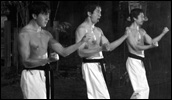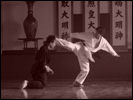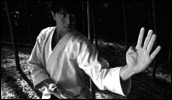Black Belt
- Year
- 2007
- Original title
- Kuro Obi
- Japanese title
- 黒帯
- Director
- Cast
- Running time
- 95 minutes
- Published
- 21 August 2007



by Tom Mes
With the recent retrospective devoted to him by the International Film Festival Rotterdam and the wide festival exposure for his remake/rethinking of Heart, Beating in the Dark (Yamiutsu Shinzo, 2006), Shunichi Nagasaki experienced something of a belated but fully justified international breakthrough last year. The Rotterdam retro marked him out as a filmmaker's filmmaker, a diligent creator of what at first glance seem like no-frills relationship dramas and thrillers, but in actual fact are highly articulate and perceptive explorations of the feverish heights (and depths) to which our human desires can push us.
Whether you had him tagged as the former or the latter, either way his latest film will come completely out of left field. Black Belt, as its title suggests, is a martial arts movie. The term inevitably conjures up notions of eardrum-piercing yelps, flying tackles and crushing bones, and of knuckleheaded musclemen of the Jean-Claude van Damme variety trying to execute such moves with some semblance of grace, but there are plenty of examples in cinema history of martial arts films that were actually films, first and foremost. Robert Wise's The Set-Up, Martin Scorsese's Raging Bull, and Akira Kurosawa's Sanshiro Sugata are three titles that spring to mind and that can rightly be considered classics, because their makers realised that the subject of any martial arts movie is human beings, their devotion to achieving their goals and what effect that devotion can have on their relationships with other human beings.
It's no accident that the word 'art' is part of the term 'martial arts', and a crucial part at that. Most martial arts movies, however, tend to overlook this in favour of the physical spectacle, or a fetishistic preoccupation with male virility and violence. Bruce Lee tried his damndest to harmonise the genre's desire for showmanship with a pure expression of the philosophies at the heart of the martial arts, but he regrettably shed his mortal coil before he could attain his goal, leaving a small body of work that ironically thrives almost entirely on spectacle. Since then, attempts at portraying "true" martial arts on screen have tended to rely on displays of physical prowess (Thai skullcrusher Ong Bak comes to mind), while any philosophising is usually a thinly veiled excuse for some good old dime store exoticism, cf. the stereotypical image of the retirement-age Asian mentor spouting riddles while tending to his bonsai collection in films like The Karate Kid.
Japanese cinema has no shortage of martial arts films that deal with the philosophical challenges of learning how to kill and maim, mostly because it had the perfect peg to this hang onto, in the shape of the giri-ninjo conflict. Since their inception, chanbara films have dealt with the way swordsmen have tried to find a balance between their deadly skills on the one hand and how and when to use them on the other, while at the same time delving into the social and political implications of giving men the right to bear and use arms. Few better examples exist than Hiroshi Inagaki's Samurai trilogy and its central figure of Musashi Miyamoto, whose entire life was a quest for a wisdom that could replace the use of violence. The socio-political angle was also exhaustively explored in the genre entries of the 1960s, by directors including Hideo Gosha, Kihachi Okamoto and Masahiro Shinoda, which film historians have often mistakenly labeled nihilists but which were in fact deeply life-affirming.
Black Belt follows firmly in this tradition, since it tries to give expression to the mindset behind the martial arts and explore the social ramifications of following through that line of thought. Set in 1932, amid the rise of militarism after the establishment of the Manchukuo colony in Northeast China, the story centers on a trio of karateka. Studying under their aging master in a small dojo in the woods of central Kyushu, Choei, Taikan and Giryu (Yagi, Tsujinaka and Suzuki, all real-life black-belt karateka) have completed their physical education, but have yet to fully grasp the spirit of their art. The opportunity to learn comes soon enough, when a company of kempeitai military police comes to requisition their dojo for use as a military barracks. Taikan and Giryu resist, and when elder member Choei is wounded in an attempt to keep the peace, they challenge the commander (Hakuryu) to a match. Even with his sword drawn, the officer is no match for Giryu, who trashes him within an inch of his life. But the fighter refuses to answer the commander's plea to finish him off lest he live with the shame of having been defeated in front of his own men. In the eyes of the military fanatics, this is a crucial mistake. When the sensei dies and a new batallion appears with rifles loaded, the three karateka have no choice but to follow orders, pack up, and go to work for the army as instructors. Along the way, however, the disgraced commander's son and daughter come to avenge their father, who committed seppuku in shame. Giryu, understanding that the only way to avoid a cycle of violence is to allow them to defeat him, lets himself be pierced by the young woman's lance. His body rolls down the hillside and is left for dead.
What marks Black Belt out for interest is not only the fact that from this moment onward Giryu and Taikan's divergent paths eventually lead them to finding their own forms of enlightenment. It is also the decision of scriptwriter Joji Iida to set the story in the early 1930s amid the rise of militarism. The opening narration (by frequent Nagasaki lead Takashi Naito) over a montage of newspaper headlines and archival photographs sets the scene, recounting the founding of Manchukuo and the assassination of the initially pro-militarist Prime Minister Inukai at the hands of a band of young naval officers. Manchukuo was the outcome of a military campaign that had been initiated by what is known as the "Manchurian Incident", in which leaders of the Japanese occupational forces in Northeast China staged an attack on one of their own supply routes and successfully blamed it on the Chinese. This was part of a carefully laid plan to give the army an excuse to penetrate deeper into Manchuria. Despite the military action being entirely insubordinate, an indecisive Emperor Hirohito neglected to punish rebel officers, thus giving the military increasing power and leeway and weakening the influence of the government.
Such factual political backgrounding is becoming increasingly rare in today's political climate, in which prominent government figures are expressing right-wing revisionist ideas with alarming frequency and openness. Former PM Junichiro Koizumi's visits to the Yasukuni shrine, school textbook revisions that hush up sensitive issues related to such war crimes as the comfort women, and the required reciting of the national anthem in class are just a few examples of these ideas being turned into policy and shaping the daily lives of the Japanese - particularly the as-yet ignorant young - with the intent of distorting historical fact in favour of ideology.
Where there is ideology, there is propaganda, meaning that the movies have not been spared from such meddling. Bolstered by the box office successes of Yamato (Otokotachi no Yamato, 2005), about the final days of the Imperial Navy's doomed mega-battleship, and Japan Sinks (Nihon Chinbotsu, 2006), which revisited and referred to WWII through a decidedly rose-tinted haze of heroism and the glory of self-sacrifice, Tokyo governor and former novelist Shintaro Ishihara mounted For Those We Love (Ore wa Kimi no Tame ni Koso Shini ni Iku, 2007), a blatantly revisionist pamphlet disguised as an ode to kamikaze pilots. Scripted by Ishihara and directed by Taku Shinjo, the film attempts to rewrite history by placing apologist concepts created after the war in the mouths of those who actually fought it. An early scene sees a high-ranking Navy officer played by Masato Ibu voicing one of the revisionists' favourite pieces of rhetoric, that Japan entered the Pacific War to "free its Asian brothers from white imperialism."
None of these ideas or attempts to spread them are new. In the 1990s films like Pride (Pride: Unmei no Toki, 1997, directed by Female Convict Scorpion helmer Shunya Ito) and Merdeka (Murdeka, 2000) vented exactly the same discourse. The difference is that now these productions are no longer isolated attempts by a handful of fanatics, but blockbusters that employ large budgets, established stars (Tatsuya Nakadai, Takashi Sorimachi, and Kyoka Suzuki in Yamato; Keiko Kishi and Yosuke Kubozuka in For Those We Love) and the distribution channels of major studios. Against such vulgar displays of power, the few initiatives that try (or should we say dare) to go against the grain hardly add up to a counterbalance, seeing how most of them are of the low budget indie variety. One such attempt is the locally-made Gama: Shell Ginger Flower (GAMA - Getto no Hana, directed by Yutaka Osawa in 1996 but never properly released), which portrays the Battle of Okinawa from the viewpoint of the local populace and focuses on the strife between the military and the people forced to do its bidding.
Like Gama, Black Belt puts up a very gallant fight against the odds. Much like Masato Harada's Kamikaze Taxi a decade earlier, it holds up something that is part of Japan's soul and tradition, and contrasts its virtues with the lowly conniving of those who claim to hold the monopoly on defining what constitutes Japaneseness. As Giryu's willingness to be defeated at the hands of the commander's daughter attests, martial arts and violence are two very different things. Violence is self-perpetuating and leaves no room for mercy, restraint or humility.
Taikan and Giryu represent the opposites of darkness and light. Taikan relishes the opportunity to fight stronger opponents, seduced as he is by the "dark side" represented by the kempeitai, who use his strength to their own ends in commandeering other dojos in the region, thus nipping any form of danger and organised dissent in the bud. But where Taikan's abuse of his powers veers toward gratuitous brutality, Giryu's views of his art as one to be used purely for defensive purposes make him passive and fatalistic. When loansharks come to take away the daughter of the family that nursed him back to health, as compensation for the father's gambling debts, he doesn't interfere. Her little brother calls him a coward, and the boy is right. Taikan and Giryu form the yin and the yang, who have yet to realize that they need to accept a part of the other within themselves to find balance and harmony, and thus learn the ultimate lesson they search for. When they leave the dojo, they may be highly trained, but they are still essentially children: raised in the protective bubble of the karate dojo, they have been taught but they have never truly experienced.
This narrative deals with some very fundamental moral dilemmas inherent in the martial arts (and in Buddhism in general), and does so with great clarity. No need to have spent years in a Kyoto monastery to grasp what is being said. Though reportedly extensively rewritten by the director, the screenplay by Iida - maker of such unremarkable fantasy fare as Battle Heater (1989), The Spiral (Rasen, 1998) and Dragonhead (2003) - gives the story the shape of a classic morality tale that borrows from the European tradition of the parable, the all-human equivalent of the fable, in which the main characters represent modes of behaviour and their actions ultimately lead to a moral lesson for the audience that is spelled out in the final moments. The story can also be interpreted as an allegory of the Manchurian campaign, with the military police conquering one dojo (or town) after another, using vainglorious local boy Taikan as their all too willing puppet.
When the lesson is finally learned, us world-wise contemporary viewers may scoff and find it obvious, but we would be wrong to do so. The lesson is not obvious, it just seems that way, because it is so clearly and understandably communicated. Director Nagasaki's approach is entirely in keeping with the central point. His sober style reflects the concept of self-restraint, portraying the martial arts scenes without spectacle but with full intensity, bringing out the best in his two non-professional leads both as actors and as martial artists. His direction calls to mind several films by one of Japan's great directors of martial arts films, Kenji Misumi, most notably the 1964 Yukio Mishima adaptation Ken, about two students with opposing world views vying for control of a university kendo school, and the late director's final film Last Samurai (Okami yo Rakujitsu o Kire, 1975), set in the turbulent closing days of the Tokugawa shogunate and focusing on a character who has to choose between violence and restraint. Black Belt's finale, shot in low-contrast grey tones for reasons that will become apparent to the viewer, forms a magnificent summation to a film that fights not only a gallant fight, but a very necessary one. And although the odds are unfair, it is not a lost cause yet.